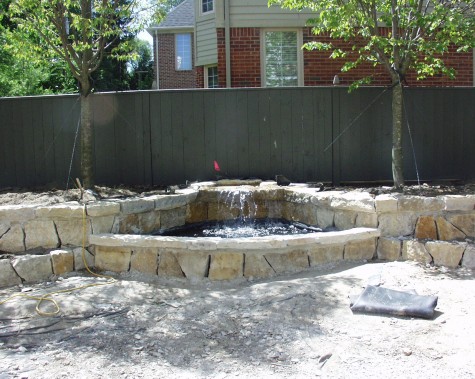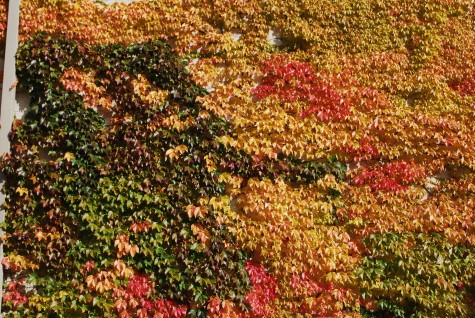 I have never forgotten my ninth grade science teacher, Dr. Watson. He concluded every lecture or discussion with the statement, “And that is the beauty of science”. Though at the time I thought he was a crackpot, I now know he was absolutely right. Today I am thinking about Parthenocissus Tricuspidata; Boston Ivy is an ordinary plant with a fancy scientific name whose primary claim to fame is its ability to grip to and cover walls with dense sheets of leaves. Why today? The fall color of Boston Ivy is one of nature’s most spectacularly glowing moments, ranking right up there with the aurora borealis.
I have never forgotten my ninth grade science teacher, Dr. Watson. He concluded every lecture or discussion with the statement, “And that is the beauty of science”. Though at the time I thought he was a crackpot, I now know he was absolutely right. Today I am thinking about Parthenocissus Tricuspidata; Boston Ivy is an ordinary plant with a fancy scientific name whose primary claim to fame is its ability to grip to and cover walls with dense sheets of leaves. Why today? The fall color of Boston Ivy is one of nature’s most spectacularly glowing moments, ranking right up there with the aurora borealis.
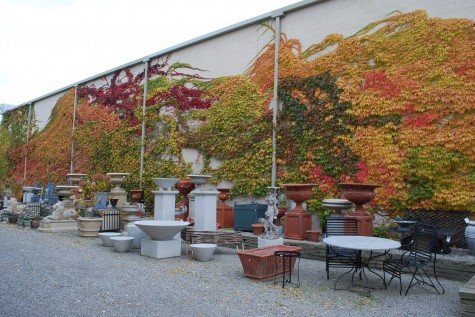 One wall of the building next door to me sits right on my property line; that would be just about two thousand square feet of beige concrete block. Needless to say, I was not too crazy about the look. Five Boston Ivy plants have just about transformed that wall in four years time; today it is looking exceptionally good. The science behind all this color-the formation of the abcission layer. Don’t black out; I’m talking about the beauty of science here. As soon as the nights get long enough in the fall, the cells that connect the leaves to the stems begin to rapidly divide-but they do not expand. This produces a brittle callus, which slows, and finally prevents the flow of nutrients from the stem to the leaves. The plant is going dormant, and putting any expenditure of energy on hold. This is a survival mechanism, the instinct to preserve life, and the beauty of science.
One wall of the building next door to me sits right on my property line; that would be just about two thousand square feet of beige concrete block. Needless to say, I was not too crazy about the look. Five Boston Ivy plants have just about transformed that wall in four years time; today it is looking exceptionally good. The science behind all this color-the formation of the abcission layer. Don’t black out; I’m talking about the beauty of science here. As soon as the nights get long enough in the fall, the cells that connect the leaves to the stems begin to rapidly divide-but they do not expand. This produces a brittle callus, which slows, and finally prevents the flow of nutrients from the stem to the leaves. The plant is going dormant, and putting any expenditure of energy on hold. This is a survival mechanism, the instinct to preserve life, and the beauty of science.
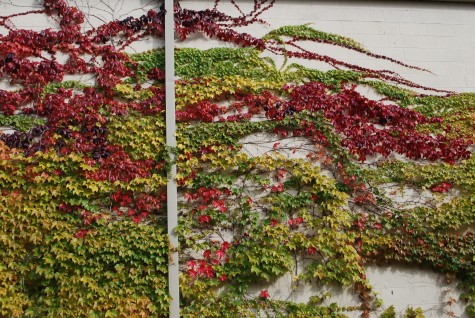 At the same time, the leaves slow down and eventually quit producing chlorophyll-that chemical that makes leaves green. If chlorophyll is not constantly manufactured in a leaf, the leaf will fade in sunlight. Chlorophyll masks the other pigments existing in leaves; the yellows, oranges and reds that were there all along are revealed when the production of chlorophyll ceases.
At the same time, the leaves slow down and eventually quit producing chlorophyll-that chemical that makes leaves green. If chlorophyll is not constantly manufactured in a leaf, the leaf will fade in sunlight. Chlorophyll masks the other pigments existing in leaves; the yellows, oranges and reds that were there all along are revealed when the production of chlorophyll ceases.
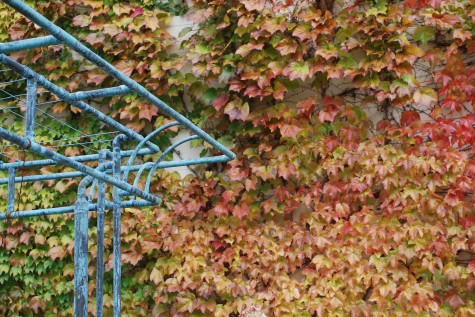 Though day length triggers this process, the temperatures, the moisture in the soil, and sunlight influence the overall show. A dry growing season can encourage leaves to drop early before they reveal any color. High winds can sever the dry corky abscission layer with the same result. At any rate, the variation and intensity of color on this wall is different every year given weather conditions. I can see that light, water, wind, sun and overnight temperatures affect the leaves on wall at different rates.
Though day length triggers this process, the temperatures, the moisture in the soil, and sunlight influence the overall show. A dry growing season can encourage leaves to drop early before they reveal any color. High winds can sever the dry corky abscission layer with the same result. At any rate, the variation and intensity of color on this wall is different every year given weather conditions. I can see that light, water, wind, sun and overnight temperatures affect the leaves on wall at different rates.
 It is easy to see the chlorophyll fading at different rates in different leaves-the color variation within each individual leaf is beautiful.
It is easy to see the chlorophyll fading at different rates in different leaves-the color variation within each individual leaf is beautiful.
 Anthocyanins are responsible for the red and purple pigments in leaves. They are manufactured from sugars that are trapped in the leaf. Oddly enough, these pigments are not present in leaves during the growing season. The role of these pigments is not so well understood. If you are interested in reading more about it, The United States National Arboretum has an excellent article on line about the science of color in autumn leaves.
Anthocyanins are responsible for the red and purple pigments in leaves. They are manufactured from sugars that are trapped in the leaf. Oddly enough, these pigments are not present in leaves during the growing season. The role of these pigments is not so well understood. If you are interested in reading more about it, The United States National Arboretum has an excellent article on line about the science of color in autumn leaves.
 Metasequoia Glyptostroboides-I wish this were my name. The Dawn Redwood is an ancient evergreen tree with a twist; it drops its needles in the fall, after turning this glorious peachy orange. This deciduous evergreen is an anomaly amongst evergreens, which ordinarily hold their foliage all winter.
Metasequoia Glyptostroboides-I wish this were my name. The Dawn Redwood is an ancient evergreen tree with a twist; it drops its needles in the fall, after turning this glorious peachy orange. This deciduous evergreen is an anomaly amongst evergreens, which ordinarily hold their foliage all winter.

The brilliant colors of fall leaves holds but a very short time. These pigments break down when exposed to light, or heavy frost. The brown color you see in these leaves is a result of the only pigment left-the tannins. The story of parthenocissus is not only about the beauty of science. It is just as much the story of the miracle that is nature.
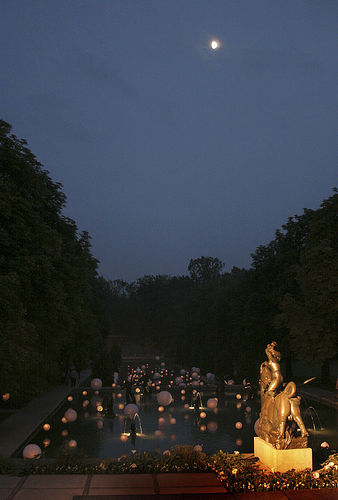
 The benefactor tables surrounding the upper level Orpheus fountain glowed with the soft light from hundreds of votive candles set on their surfaces. The white tablecloths, umbrellas, garden flowers,the costumes of the dance troup and water reflected light in every direction. This kind of romance makes people feel good.
The benefactor tables surrounding the upper level Orpheus fountain glowed with the soft light from hundreds of votive candles set on their surfaces. The white tablecloths, umbrellas, garden flowers,the costumes of the dance troup and water reflected light in every direction. This kind of romance makes people feel good.  The votive-lit lanterns skimming the surface of the Triton pools were repeated ingound, lighting the path from the entrance to the event, to its center. Designing and creating a walk to the event gave every guest the chance to shift their visual gears from their every day landscape to this specially made and momentary landscape. This transition helps to build anticipation for the event; when I have the idea I am going to enjoy something, I usually do.
The votive-lit lanterns skimming the surface of the Triton pools were repeated ingound, lighting the path from the entrance to the event, to its center. Designing and creating a walk to the event gave every guest the chance to shift their visual gears from their every day landscape to this specially made and momentary landscape. This transition helps to build anticipation for the event; when I have the idea I am going to enjoy something, I usually do.
 I had not thought about the fact that the level of glow the one votive candle tucked into each sphere would vary greatly given the size of that sphere. That variation in light level proved especially beautiful – courtesy of a little physics via the umbrella we call nature.
I had not thought about the fact that the level of glow the one votive candle tucked into each sphere would vary greatly given the size of that sphere. That variation in light level proved especially beautiful – courtesy of a little physics via the umbrella we call nature.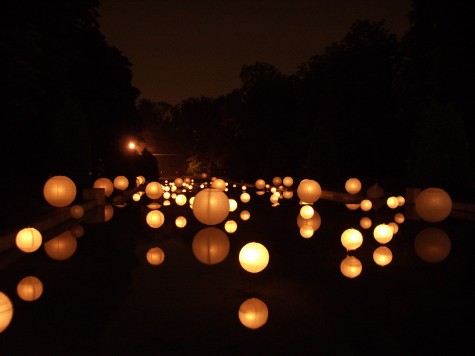 As the evening wore on, the intensity of light emitted from the spheres, and the diminishing ability to gauge the water level gave the impression that all the spheres were floating on, or hovering over the water.
As the evening wore on, the intensity of light emitted from the spheres, and the diminishing ability to gauge the water level gave the impression that all the spheres were floating on, or hovering over the water.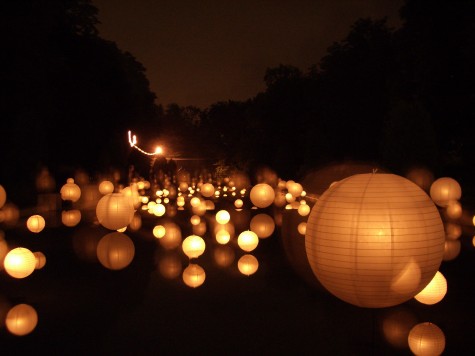 The reflection of the spheres in the still water made it seem like the spheres were multiplying. The water, the weather, and the light acting on those spheres made this event. How weather acts on a landscape is a critical factor in its success. I do my best work when I am paying attention to that.
The reflection of the spheres in the still water made it seem like the spheres were multiplying. The water, the weather, and the light acting on those spheres made this event. How weather acts on a landscape is a critical factor in its success. I do my best work when I am paying attention to that. Of course there would be music, dining and dancing. The bidding on the art at auction was brisk; people were enjoying themselves. It was such a pleasure seeing the Triton pools, and their sculptures at night.
Of course there would be music, dining and dancing. The bidding on the art at auction was brisk; people were enjoying themselves. It was such a pleasure seeing the Triton pools, and their sculptures at night. The perfect moment that night? The coming of the frogs. Late in the evening, the spheres were host to many hundreds, maybe thousands, of frogs. They gravitated to the spheres, and took up residence. Everyone could hear them singing, before anyone spotted where they were perched. Some said the rhythm of that singing matched the rhythm of the music; I choose to believe that was so.
The perfect moment that night? The coming of the frogs. Late in the evening, the spheres were host to many hundreds, maybe thousands, of frogs. They gravitated to the spheres, and took up residence. Everyone could hear them singing, before anyone spotted where they were perched. Some said the rhythm of that singing matched the rhythm of the music; I choose to believe that was so. 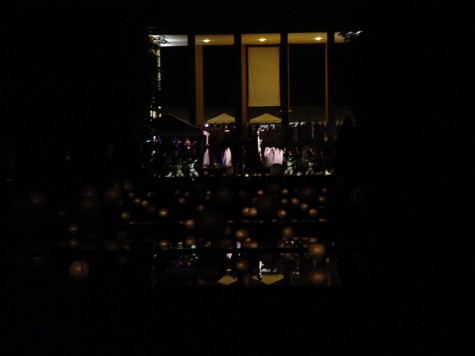


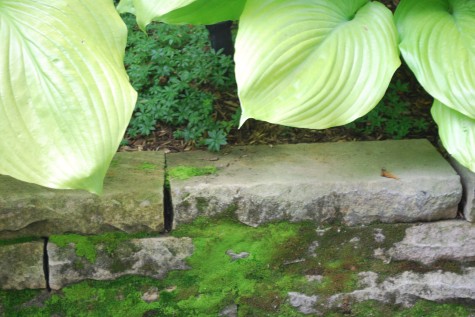
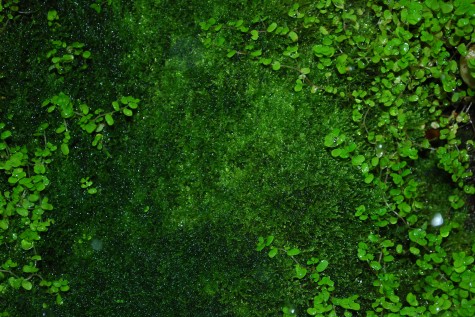
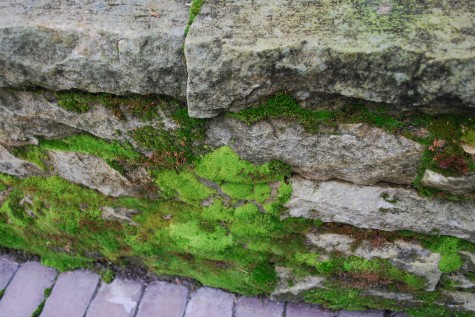

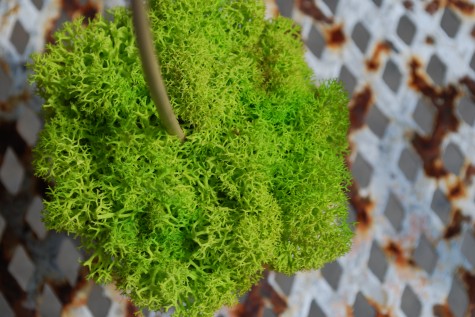
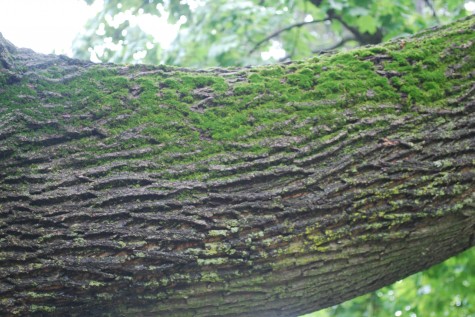
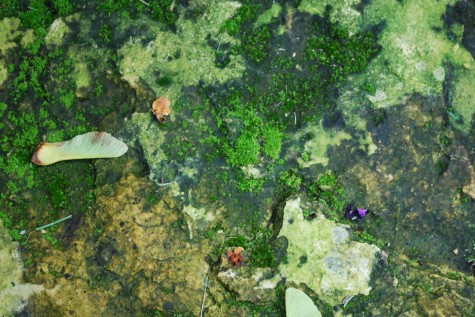

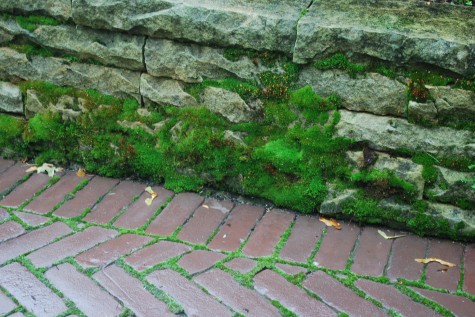

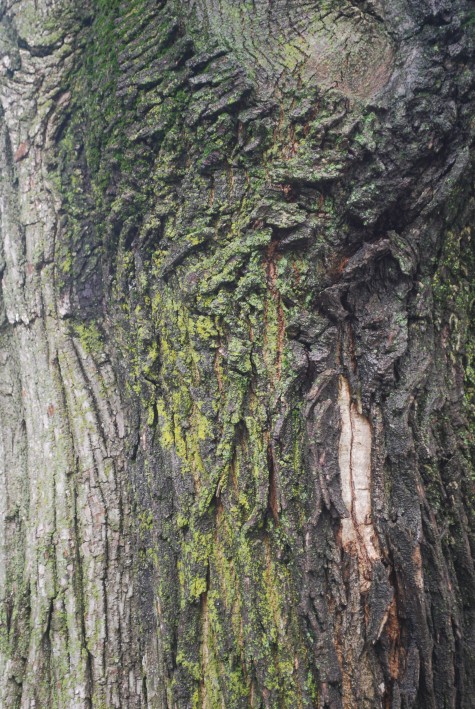
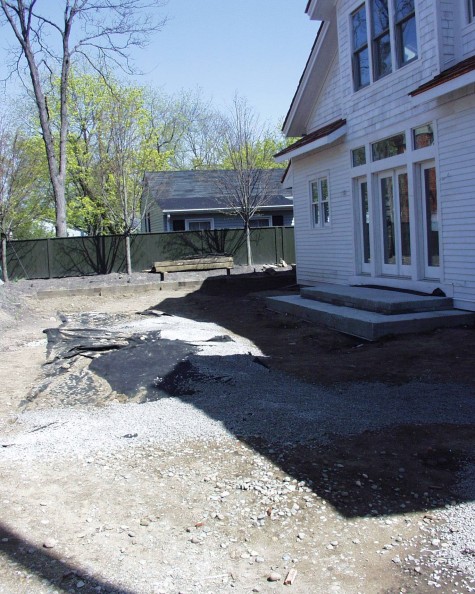
 A retaining wall of pressure treated lumber was installed near the lot line; the lindens were planted some sixteen inches above grade. A six foot high wood fence, painted “disappearing green”, would provide complete screening at the tree level. My clients are very fond of the buildings in New Harmony, Indiana. All of the later additions and modifications to the original architecture have been painted “disappearing green”-a color which recedes from view such that it is easy to see the original architectural intent of the buildings. I would describe the color as a dark muddy green brown. With the trees and fence in place, the screening would be a dominant element of the garden, but occupy a very small space. I lowered the ground plane as much as I could without endangering the drainage of the loqwer level. The trees instantly gained 18 inches in height; this placement put the lower branches of the lindens just above the top of the fence. This is what I would call engineering one’s screening.
A retaining wall of pressure treated lumber was installed near the lot line; the lindens were planted some sixteen inches above grade. A six foot high wood fence, painted “disappearing green”, would provide complete screening at the tree level. My clients are very fond of the buildings in New Harmony, Indiana. All of the later additions and modifications to the original architecture have been painted “disappearing green”-a color which recedes from view such that it is easy to see the original architectural intent of the buildings. I would describe the color as a dark muddy green brown. With the trees and fence in place, the screening would be a dominant element of the garden, but occupy a very small space. I lowered the ground plane as much as I could without endangering the drainage of the loqwer level. The trees instantly gained 18 inches in height; this placement put the lower branches of the lindens just above the top of the fence. This is what I would call engineering one’s screening.  Of course that sixteen inches of soil was not going to stay put without some retaining on the front edge as well. My clients chose a rustic stone for the tree planter box walls, and the retaining for the garden beds. You see stone laid out everywhere on the site; the stone mason needs to pick and choose which stones fit together so the mortar joints are small and unobtrusive. It would be three steps up into the house; I made them deep and wide-easy to navigate. It was most important to them to have a private garden; they were willing to deal with the up and down.
Of course that sixteen inches of soil was not going to stay put without some retaining on the front edge as well. My clients chose a rustic stone for the tree planter box walls, and the retaining for the garden beds. You see stone laid out everywhere on the site; the stone mason needs to pick and choose which stones fit together so the mortar joints are small and unobtrusive. It would be three steps up into the house; I made them deep and wide-easy to navigate. It was most important to them to have a private garden; they were willing to deal with the up and down. 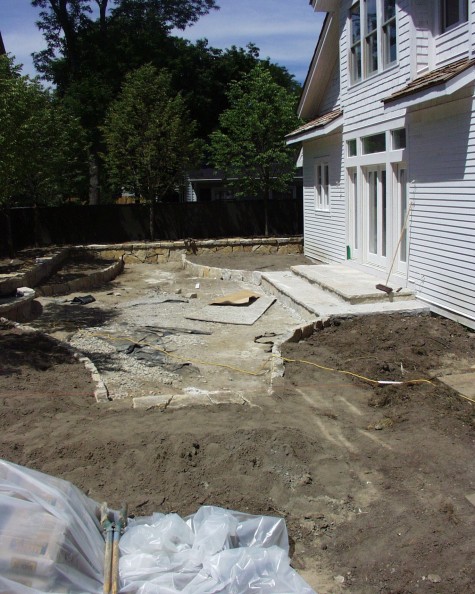 The sixteen inches of plant mix filling these beds would vastly improve the quality and drainage of the soil. The garden would be easy to plant, and weed. The worst thing about weeds-how far they are away from your fingers, and what your back has to do in order to get your fingers where they need to be. An entire tool industry is built around that distance. These gardens would be closer to the hands maintaining them.
The sixteen inches of plant mix filling these beds would vastly improve the quality and drainage of the soil. The garden would be easy to plant, and weed. The worst thing about weeds-how far they are away from your fingers, and what your back has to do in order to get your fingers where they need to be. An entire tool industry is built around that distance. These gardens would be closer to the hands maintaining them.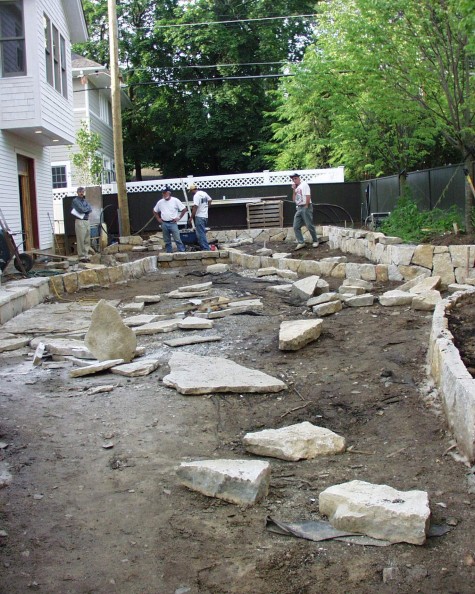
 This landscape would eventually have three distinct levels. The change of grade would provide a lot of visual interest for a very small space. Not incidentally, a sunken garden dramatically reduces ambient noise. Earth is the only thing which really blocks sound; no amount of plant material will screen out unwelcome noise. Homes built in close proximity face both audial and visual screening issues. I like living in a neighborhood, but am I enchanted with my neighbor’s kids shrieking or the sound of their lawn mower-no, not so much.
This landscape would eventually have three distinct levels. The change of grade would provide a lot of visual interest for a very small space. Not incidentally, a sunken garden dramatically reduces ambient noise. Earth is the only thing which really blocks sound; no amount of plant material will screen out unwelcome noise. Homes built in close proximity face both audial and visual screening issues. I like living in a neighborhood, but am I enchanted with my neighbor’s kids shrieking or the sound of their lawn mower-no, not so much.